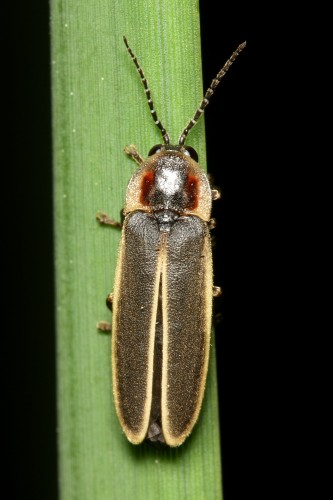Today’s guest post is by Stephen Luk, the lead author of Fireflies of Ontario (Coleoptera: Lampyridae), which was recently published in the Canadian Journal of Arthropod Identification. Stephen is an M.Sc. candidate at the University of Guelph as part of the Insect Systematics Lab, and while his main research is now focusing on Sphaeroceridae taxonomy, he has maintained a keen interest in the remaining Insecta. Stephen is a frequent contributor to BugGuide.net, and an avid nature photographer.
Over the moist meadows where stargazers behold the star-studded sky, insect enthusiasts can admire the summer scintillations of fireflies. Their neon glows spark fond childhood memories: of fields lit by symphonic displays; of brilliant twinkling in a jar set among the grass or over a book. But the fireflies of lore and poetry are truthfully poorly understood. They are often difficult to identify both in the field and in the laboratory. The shape and colour of a species can vary bewilderingly, and only an informed observer is capable of confidently identifying species amid the dazzling nocturnal orchestration. This is said of adults, and scarcely of immature stages, the knowledge of which is mostly sparse to absent.
Thankfully, the confusion is subsiding with the advent of novel identification tools. “The Fireflies of Ontario (Coleoptera: Lampyridae)”, published in the Canadian Journal of Arthropod Identification, features an updated list of Ontario fireflies as well as a comprehensive and user-friendly key to adult fireflies in Canada east of Ontario. Users will discover a practical platform upon which to illuminate the fascinating lives of fireflies. This resource arrived just as these wonderful beetles mesmerized the public with their seasonal light shows. Fireflies were certainly well represented this summer in southwestern Ontario — I observed nearly a dozen species upon a few occasions here in Guelph.
Behind the scenes with fireflies
I became acquainted with fireflies as an undergraduate student, and was appalled that creatures so familiar were so harrowing to identify. Thus, I assembled obscure literature, meticulously determined specimens and wrestled long with species in the genus Photinus (remarkably similar species in this region). I amalgamated and redesigned keys while gladly illustrating them with pinned specimens, but disapproved the paucity of suitable live images, and have since embarked on a quest to rectify this personally. The product was defended and published fourteen months later, rendering Ontario’s adult fireflies identifiable. I have since accumulated additional images, and was even privileged to dispense some expertise through the CBC.
Steve was also interviewed for an article in the London Free Press
![]() Luk, S., Marshall, S., & Branham, M. (2011). The Fireflies of Ontario (Coleoptera: Lampyridae) Canadian Journal of Arthropod Identification DOI: 10.3752/cjai.2011.16 OPEN ACCESS
Luk, S., Marshall, S., & Branham, M. (2011). The Fireflies of Ontario (Coleoptera: Lampyridae) Canadian Journal of Arthropod Identification DOI: 10.3752/cjai.2011.16 OPEN ACCESS

